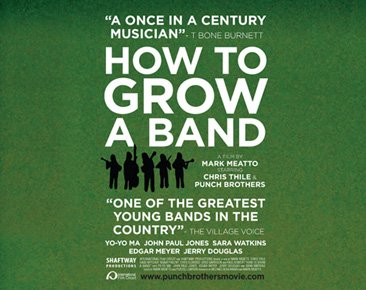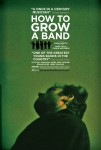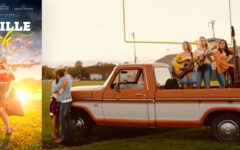
 Finally! After three years of shooting and editing – and another year of finagling and politicking – the Punch Brothers movie, How To Grow A Band, is set to hit the screen this week.
Finally! After three years of shooting and editing – and another year of finagling and politicking – the Punch Brothers movie, How To Grow A Band, is set to hit the screen this week.
This highly-anticipated independent documentary is the work of Mark Meatto, who began filming the band starting in 2008 when Punch, the group’s debut release as Punch Brothers, was about to be released. Yes… serious fans know that this same group of musicians (Chris Thile, Chris Eldridge, Noam Pikelny, Gabe Witcher and Greg Garrison) had released an album together prior to Punch. Mark playfully recognizes this in the project’s title, which carries the same name the quintet performed under in support of their initial recorded offering in 2006, How To Grow A Woman From The Ground.
I had the opportunity to both watch the film and discuss it with Meatto earlier this week, and can assure Bluegrass Today readers that How To Grow A Band is an authentic telling of the Punch Brothers’ artistic and logistical journey from their first public performances of The Blind Leaving The Blind, Thile’s string band opus in 4 movements, through the band’s transition to new bass player Paul Kowert later in ’08. Footage from beyond that time is included, but the story arc of the documentary centers on the successes and failures, uncertainties and interpersonal squabbles they go through in bringing this complex piece to the stage.
Someone with no outside knowledge of the band, The Blind Leaving The Blind, or what has transpired since will certainly find much to enjoy here. But those of us who have carefully followed Punch Brothers’ subsequent work, and their evolution into an acoustic string band performing tightly crafted modern pop music, will especially cherish this intimate look into their early struggles taking an innovative piece of music to an initially unwelcoming audience.
In speaking with Meatto, I was initially curious about the delay between shooting and the film’s debut in New York City this weekend.
“Well, this has been an independent production from top to bottom, with a very small team, just the two of us [with co-producer Michael Bohlman]. The three years it took to shoot and edit is not terribly uncommon for a documentary of this length and style. The extra year (since last April), is the result of running into a lot of closed doors from the tastemakers and gatekeepers that seem to control what films get seen.
It took that year to convince people that there is an audience for this film, and that it should be seen.”
Meatto and Bohlman have arranged for non-traditional distribution, using a company that functions more like a booking agent. Their distributor will contact theaters on the film’s behalf, with the producers retaining all rights. In addition, a crowd sourcing campaign will start next week on Kickstarter to raise funds for publicity and marketing.
“We’ll be asking people to demonstrate support to help us get it into theaters across the US. Our goal is to get the film booked into 25-40 cities. There will be some cool rewards for people who donate.
We believe that once people start seeing the film, it will build it’s own support – and bring in new fans for bluegrass music. We’ve held screenings where people had never heard a mandolin before, and then report back later that they had gone out and gotten a Bill Monroe record.”
 This is a very candid film, with the band providing unfettered access during the time Mark was shooting. Doubts about the direction the band or the tour were taking are expressed by the various members, including a very telling discussion amongst themselves in Thile’s absence. Still, the admiration these men have for each other, both musically and personally is equally clear, captured both on stage and off.
This is a very candid film, with the band providing unfettered access during the time Mark was shooting. Doubts about the direction the band or the tour were taking are expressed by the various members, including a very telling discussion amongst themselves in Thile’s absence. Still, the admiration these men have for each other, both musically and personally is equally clear, captured both on stage and off.
Mark was quick to point out that none of that was staged, or managed in the sense that contemporary realty television is produced, and that while he did capture tension in the film, it was all genuinely delivered, and from a standpoint of intense mutual respect.
“Everyone’s expecting name-calling… plates thrown against the wall. Not only is that not what I saw, it’s not something I wanted to underscore in the film. These are highly emotionally-intelligent people, and this music is something very serious to them.”
It struck me as counterintuitive that virtuoso musicians would allow a documentarian into such a critical point in their careers. Success was not a given, even considering all that Thile had attained with Nickel Creek, and an extra set of eyes backstage, in the van and in the hotel rooms could have been a serious distraction. Not to mention the possibility of having a film record had things gone badly.
But trust had already been established before the first inches of film rolled. Bohlman and Gabe Witcher were childhood friends, and Meatto had been roommates with Infamous Stringdusters banjo player Chris Pandolfi several years back in Boston. Pandolfi and Eldridge had been close friends for some time, and Chris’ nod carried plenty of weight with the Punchers.
In fact, it was Bohlman who brought the idea for this project to Meatto after having produced a live concert DVD for Nonesuch Records that was included in special editions of Punch Brothers’ Antifogmatic album in 2010.
The film’s opening may be a bit disconcerting at first, as it seems to “just start” with the band traveling to Scotland for the first live performances of The Blind Leaving The Blind. Over the next few minutes, however, even audiences uninitiated in the backstory will be pulled into the narrative.
One very effective aspect of the film is that all of the music is taken from live performances captured during the shooting, and none from the album. Not every minute of Thile’s lengthy composition is heard, though a substantial portion is presented. Sometimes in rehearsal, other times on stage, the music intercut with interviews, road and backstage footage, and various members’ reflections and conversations over the course of the time they spent with the filmmakers.
http://vimeo.com/39351113
Interestingly, the only movement performed uninterrupted is the third, which I have always found to be the most musically compelling and lyrically profound portion of the piece. To my ear, it most successfully utilizes the various “bluegrass” instruments and their individual capabilities, and seamlessly merges the rhythms and pulses of bluegrass with whatever you might choose to call Punch Brothers music.
continued…







